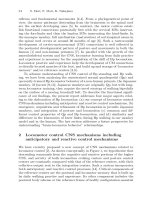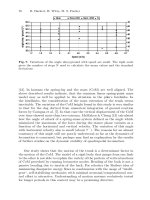Scott et al (eds ) ending government bailouts as we know them (2010)
Bạn đang xem bản rút gọn của tài liệu. Xem và tải ngay bản đầy đủ của tài liệu tại đây (2.42 MB, 352 trang )
Ending
Government
Bailouts
As We Know Them
Copyright © 2010 by the Board of Trustees of the Leland Stanford Junior University. All rights reserved.
Copyright © 2010 by the Board of Trustees of the Leland Stanford Junior University. All rights reserved.
Ending
Government
Bailouts
As We Know Them
edited by
Kenneth E. Scott
George P. Shultz
John B. Taylor
authors
Nicholas F. Brady
Darrell Duffie
Joseph Grundfest
Richard Herring
Thomas M. Hoenig
Thomas Jackson
William F. Kroener III
Charles S. Morris
Kenneth E. Scott
George P. Shultz
Kenneth Spong
Johannes Stroebel
Kimberly Anne Summe
John B. Taylor
Paul Volcker
Hoover Institution Press
Stanford University
Stanford, California
Copyright © 2010 by the Board of Trustees of the Leland Stanford Junior University. All rights reserved.
The Hoover Institution on War, Revolution and Peace, founded
at Stanford University in 1919 by Herbert Hoover, who went on
to become the thirty-first president of the United States, is an
interdisciplinary research center for advanced study on domestic and
international affairs. The views expressed in its publications are entirely
those of the authors and do not necessarily reflect the views of the staff,
officers, or Board of Overseers of the Hoover Institution.
www.hoover.org
Hoover Institution Press Publication No. 588
Copyright © 2009 by the Board of Trustees of the
Leland Stanford Junior University
All rights reserved. No part of this publication may be reproduced,
stored in a retrieval system, or transmitted in any form or by any means,
electronic, mechanical, photocopying, recording, or otherwise, without
written permission of the publisher.
Chapter 10, “The Kansas City Plan,” by Thomas M. Hoenig, Charles S.
Morris, and Kenneth Spong, appears in this publication with the
permission of the Federal Reserve Bank of Kansas City. Copyright
© 2009 by the Federal Reserve Bank of Kansas City.
First printing, 2010
16 15 14 13 12 11 10
9 8 7 6 5 4 3 2 1
Manufactured in the United States of America
The paper used in this publication meets the minimum requirements
of the American National Standard for Information Sciences—
Permanence of Paper for Printed Library Materials,
ANSI Z39.48–1992. oo
Cataloging-in-Publication Data is available from Library of Congress
ISBN 978-0-8179-1124-9 (cloth: alk. paper)
ISBN 978-0-8179-1123-2 (e-book versions)
Copyright © 2010 by the Board of Trustees of the Leland Stanford Junior University. All rights reserved.
Contents
ix
Preface
Kenneth E. Scott, George P. Shultz, and John B. Taylor
Acknowledgments
xiii
Part I
The Danger of Bailouts and Key Principles of Reform
1
2
3
Make Failure Tolerable
George P. Shultz
3
Financial Reforms to End Government
Bailouts as We Know Them
Paul Volcker
11
Fifty Years in the Business: From Wall Street
to the Treasury and Beyond
Nicholas F. Brady
21
Part II Systemic Risk in Theory and in Practice
4
Defining Systemic Risk Operationally
John B. Taylor
33
5Lessons Learned from the Lehman Bankruptcy 59
Kimberly Anne Summe
v
Copyright © 2010 by the Board of Trustees of the Leland Stanford Junior University. All rights reserved.
vi
Contents
Part III What Financial Firms Can Do
6
7
8
A Contractual Approach to Restructuring
Financial Institutions
Darrell Duffie
109
Wind-down Plans as an Alternative
to Bailouts: The Cross-Border Challenges
Richard J. Herring
125
Wind-down Plans, Incomplete Contracting,
and Renegotiation Risk:
Lessons From Tiger Woods
Joseph A. Grundfest
163
Part IV Bankruptcy versus Resolution Authority
9
10
11
12
Expanding FDIC-Style Resolution Authority 179
William F. Kroener III
The Kansas City Plan
Thomas M. Hoenig, Charles S. Morris,
and Kenneth Spong
189
Chapter 11F: A Proposal for the Use of
Bankruptcy to Resolve Financial Institutions
Thomas H. Jackson
217
Evaluating Failure Resolution Plans
Kenneth E. Scott
253
Copyright © 2010 by the Board of Trustees of the Leland Stanford Junior University. All rights reserved.
Contents
vii
A Summary of the Commentary
Johannes Stroebel
263
A Conversation about Key Conclusions
George P. Shultz and John B. Taylor
285
291
Appendix: The Financial Crisis:
Causes and Lessons
Kenneth E. Scott
About the Authors
Index
313
323
Copyright © 2010 by the Board of Trustees of the Leland Stanford Junior University. All rights reserved.
Copyright © 2010 by the Board of Trustees of the Leland Stanford Junior University. All rights reserved.
Preface
Last spring, around the time Congress began
considering and modifying the financial reforms proposed
by the U.S. Treasury, our Working Group on Economic
Policy at the Hoover Institution decided to establish a
“Resolution Project” to focus on alternative ways to deal
with failing financial institutions. We were motivated by
the growing backlash around the country about the bailouts and our own concerns that the bailout mentality was
a grave danger to the country. The Resolution Project
included Andrew Crockett, Darrell Duffie, Richard Herring, Thomas Jackson, William Kroener, Kenneth Scott,
George Shultz, Kimberly Summe, and John Taylor. Ken
Scott became the chairman of the Project and recruited
the participants, organized the meetings, and provided
overall leadership.
The first meeting of the Resolution Project was held in
August, and soon we found ourselves diving into the weeds
of qualified financial contracts, convertible contingent debt,
the third party repo market, and the U.S. Bankruptcy Code.
We had no choice other than to get into these details if we
were going to understand, let alone solve, the bailout problem. But we also had to be able to pull back from the weeds,
and so George Shultz wrote down some broad ideas organized around the theme “Make Failure Tolerable.” From this
theme we then decided to broaden our scope and aim the
ix
Copyright © 2010 by the Board of Trustees of the Leland Stanford Junior University. All rights reserved.
x
Preface
work of the Resolution Project toward a conference where
we would invite others to speak on related topics or to comment and critique. The conference was held in December
2009, and the papers presented there became the chapters
in this volume. We were delighted that experienced senior
policy makers such as Nick Brady, Paul Volcker, Tom Hoenig, and Gary Stern agreed to contribute and that many
distinguished attorneys and economists were able to participate and add to the commentary.
The chapters are organized into four parts. Part I starts
with George Shultz presenting the ideas and questions that
underlie the theme of the book. It then moves on to remarks
by former Federal Reserve chairman Paul Volcker and former
secretary of the Treasury Nicholas Brady. All three express
their concerns about the dangers of bailouts and call for,
among other reforms, tightening the limits on the activities
of banks with access to the Fed’s discount window as a way
to reduce the likelihood of bailouts.
Part II then examines the nature of systemic risk, starting
with a review by John Taylor of the academic and policy literature and then delving into the experience with the Lehman
Brothers bankruptcy by Kimberly Summe. A common theme
of both the literature review and the practical experience with
Lehman is that the direct connection between financial firms
appears to be a smaller problem than commonly believed. The
evidence shows that direct connections between banks in the
interbank loan market would not lead to significant cascading
and that none of the derivative counterparties to Lehman filed
bankruptcy.
Part III considers reforms that financial firms can implement, whether or not induced or required by government
Copyright © 2010 by the Board of Trustees of the Leland Stanford Junior University. All rights reserved.
Preface
xi
regulatory agencies. Darrell Duffie shows how firms’ issuance
of debt that is convertible into equity at the time of crisis
can automatically increase capital ratios just when such an
increase is needed. He also considers mandatory rights offerings with the same purpose. Richard Herring’s proposal is
that financial firms develop wind-down plans and file these
with their regulators and supervisors for approval. To deal
with international complexities, supervisors in different
countries could then develop a set of principles for winddown plans based on firms’ submissions. In the third chapter
in Part III, Joe Grundfest raises some practical implementation questions about wind-down problems and offers some
suggestions about how to deal with these problems.
Part IV explores in detail the two main alternatives to
government bailouts in the case of a failing financial firm:
bankruptcy versus resolution authority. Bill Kroener leads off
with a review of the pros and cons of expanding the FDIC
resolution authority, drawing on his experience at the FDIC.
Tom Hoenig, in a chapter coauthored with Chuck Morris
and Ken Spong, then lays out an explicit example of how a
resolution authority could operate subject to a well-understood and consistent set of rules and procedures. Tom Jackson offers a new proposal for bankruptcy for failing financial
firms, which he calls Chapter 11F. He shows how various
objections to the bankruptcy process can be dealt with in
practice. Following these proposals, Ken Scott reviews and
evaluates them from the perspective of a number of essential
elements that a good resolution process must address.
Following the chapters, Johannes Stroebel provides
a summary of the commentary on the chapters by formal discussants and the audience at the conference. The
Copyright © 2010 by the Board of Trustees of the Leland Stanford Junior University. All rights reserved.
xii
Systemic Risk in Theory and in Practice
commentary ranges from constructive critiques to strong
endorsements to ideas for future research.
While the chapters in this book cover an enormous
range of topics, several conclusions or recommendations
can be gleaned from them as well as from the commentary.
The concluding summary by George Shultz and John Taylor
endeavors to do so. Finally, a brief overview of what went
wrong is provided in an appendix by Ken Scott. It shows
that it is indeed possible to explain the causes of the crisis in
understandable terms and clarifies why resolving the bailout
problem is essential to preventing future crises.
Kenneth E. Scott, George P. Shultz,
and John B. Taylor
Copyright © 2010 by the Board of Trustees of the Leland Stanford Junior University. All rights reserved.
Acknowledgments
The conference which led to this book was the
third policy conference sponsored by the Working Group
on Economic Policy at the Hoover Institution. The first
was held in July 2008 and the second in March 2009.
We gratefully acknowledge the following individuals and
foundations, as well as those wishing to remain anonymous, for their significant support of the Working Group
and this book:
Lynde and Harry Bradley Foundation
Preston and Carolyn Butcher
Stephen and Sarah Page Herrick
William E. Simon Foundation
We wish to thank John Cogan, Darrell Duffie, Joseph
Grundfest, and other members of the Working Group for
brainstorming as we put the conference together. Many of
the chapters were written as part of the “Resolution Project”
which is also sponsored by the Working Group.
We want to thank the dedicated staff of the Hoover
Institution who helped with the conference, especially
Marie-Christine Slakey and Christy Hamilton, and those
who helped produce the book, especially Michael Bass, Marshall Blanchard, Linda Kulman, Stephen Langlois, Jennifer
xiii
Copyright © 2010 by the Board of Trustees of the Leland Stanford Junior University. All rights reserved.
xiv
Acknowledgments
Presley, Aline Magee, Julie Ruggiero, and Eryn Witcher. The
acknowledgments by authors of the chapters in the book are
referenced in the notes to the chapters.
Kenneth E. Scott, George P. Shultz,
and John B. Taylor
Copyright © 2010 by the Board of Trustees of the Leland Stanford Junior University. All rights reserved.
Part I
The Danger of
Bailouts and
Key Principles
of Reform
Copyright © 2010 by the Board of Trustees of the Leland Stanford Junior University. All rights reserved.
Copyright © 2010 by the Board of Trustees of the Leland Stanford Junior University. All rights reserved.
1
Make Failure Tolerable
George P. Shultz
These are tough times for the U.S. economy and
for many others around the world. Tense moments in the last
half of 2008 produced unprecedented actions that, according
to recently published detailed accounts, were taken without
the benefit of reflective strategy, on a case-by-case basis, and in
an environment of panic. The result, especially in the United
States, has been massive bailouts of faltering organizations
with consequent commitment of huge amounts of taxpayer
dollars and heavy involvement of the federal government
through ownership in customarily private sector activities:
selecting boards of directors and chief executives, regulating pay, and otherwise influencing corporate behavior. The
American people are clearly upset about these bailouts. In the
view of many, the people who created the problem should pay
a penalty instead of being bailed out by the taxpayers. Who
would disagree with that sentiment?
3
Copyright © 2010 by the Board of Trustees of the Leland Stanford Junior University. All rights reserved.
4
The Danger of Bailouts and Key Principles of Reform
Difficult times are still with us and clearly lie ahead.
Unemployment is high, the Fed has unleashed every trick
in its bag (and even some that no one realized were in its
bag) to stimulate the economy, government spending seems
out of control, tax rates are rising with the clear prospect
of more to come and with their well-documented disincentive effects, and protectionist actions are all too evident.
Remember, the 1930s were characterized by the heavy tax
of virulent protectionism and an increase in the top marginal income tax rate from 25 percent in 1932 to 80 percent
by 1936.
What to Do?
The way to proceed is to set a strategy designed to produce
growth based on the vigor of the private sector with inflation under control. One essential pillar of that strategy must
deal with the current bailout mentality. The right question
is, How do we make failure tolerable? If clear and credible
measures can be put into place that convince everybody that
failure will be allowed, then the expectations of bailouts will
recede and perhaps even disappear. We would also get rid of
the risk-inducing behavior that even implicit government
guarantees bring about. “Heads, I win; tails, you lose” will
always lead to excessive risk. And we would get rid of the
unfair competitive advantage given to the “too big to fail”
group by the implicit government guarantee behind their
borrowing and other activities. At the same time, by being
clear about what will happen and that failure can occur
without risk to the system, we avoid the creation of a panic
environment.









